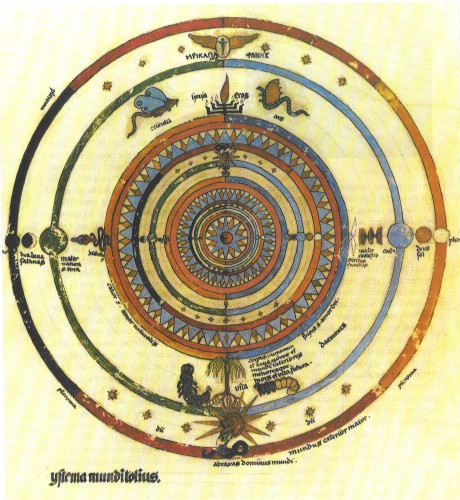World famous psychological and cultural researcher Carl Jung often used the mandala as a tool for understanding and therapy. Not only did Jung make mandalas himself—acknowledging the calming and peaceful feelings creating mandalas brought him—he would often have his patients make a spontaneous mandala each day as part of their therapy and study. This continual work with mandalas over many years gave Jung a unique and deeply insightful comprehension of the ancient and archetypal art form.
As Jung accounted in Memories, Dreams and Reflections, he quickly recognized how each mandala represented the state of the Self at the moment of making the mandala, calling them “cryptograms” of the state of the self as it was on the day the mandala was created. Over time, this gave Jung a clear understanding of the implications on the psyche and the Self. Of these cryptogram mandalas he wrote, “I guarded them like precious pearls….I saw that everything, all paths I had been following, all steps I had taken, were leading back to a single point — namely, to the mid-point. It became increasingly plain to me that the mandala is the center. It is the exponent of all paths. It is the path to the center, to individuation.” (MDR, 196)
After viewing many spontaneous mandala renderings, from many patients without prior knowledge of mandalas or symbolism, Jung noticed that over and over individuals produced similar symbols and forms. Looking broadly, one can be confirm this observation simply by looking at the countless mandala patterns from the many ages and cultures that have created them—from Tibetan sand paintings to Gothic rose windows. Most noteworthy and universal of these forms is the squaring of the circle, one of the most universal geometric forms. According to one artist and mandala researcher, this “symbolizes the application of an orderly architecture upon the infinity of the cosmos. It gives the psyche a safe place on which to stand, a solid foundation upon which it can gather itself to achieve completeness and harmony. Furthermore, the central point, or bindu, is the reference point for the self to identify with. Jung refers to this pattern as the ‘archetype of wholeness’.” (Source: Archetype of Wholeness: Jung and the Mandala, Peter Patrick Barreda)
These symbolic echoes or ripples caused Jung to conclude something very important about the forms and their relation to the human consciousness:
[quote cite=”Carl Jung, Memories, Dreams and Reflections“]In view of the fact that all the mandalas shown here were new and uninfluenced products, we are driven to the conclusion that there must be a trans-conscious disposition in every individual which is able to produce the same or very similar symbols at all times and in all places. Since this disposition is usually not a conscious possession of the individual I have called it the collective unconscious, and, as the basis of its symbolical products, I postulate the existence of primordial images, the archetypes. [/quote]
Jung’s papers on the subject are published in the book Mandala Symbolism, which asserts Jung’s heavy reliance on the mandala in developing his methods and practices—even to the development of fundamental Jungian concepts, as the previous quote insinuates. He also eluded to the mystical nature of mandalas, and their ability to reach deep into the primal self without the conscious self being cognizant of it.
[quote cite=”Carl Jung, Mandala Symbolism, Page 77″]Most mandalas have an intuitive, irrational character and, through their symbolical content, exert a retroactive influence on the unconscious. They therefore possess a “magical” significance, like icons, whose possible efficacy was never consciously felt by the patient.[/quote]
Lastly, Jung also equates the mandala with the eye—both in form and symbolically, calling the eye a “prototype for the mandala.” In nearly every culture, the eye represents seeing, insight, knowledge, awareness, wisdom, and understanding, and therefore often doubles as a symbol for consciousness itself. Beyond the obvious structural similarities between the eye and the mandala, eye imagery is commonly included in individual mandalas. The proliferation of the eye as a motif in contemporary visionary and spiritual art demonstrates this. Jung refers to this as polyopthalmia (many-eyed), and considers this a representation of the unconscious as multiple consciousnesses. In addition, the eye is the part of the individual Self that witnesses the universe and sees where that self fits in it (insinuated here is the viewpoint from the center). The eye receives or absorbs light, the purest energy of the universe, and translates it for the inner conscious observer. It is the bridge and conduit between the self-aware being inside and everything in the universe that is outside that consciousness. Thus the eye (vision) is what connects our higher awareness (thought) with all the lower chakras that are more rooted the material world (such as energy, will, and emotion). In a similar way, the mandala symbolically links the center (i.e. awareness) with everything that surrounds it (i.e the universe). (Source: Archetype of Wholeness: Jung and the Mandala, Peter Patrick Barreda)
-am. Feb 2014
Read other Blogs in my What is a Mandala Series

